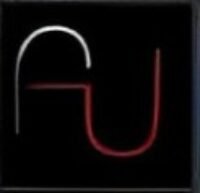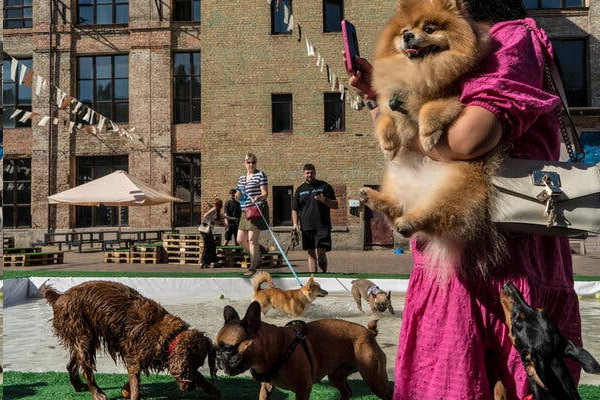
For two days in September 2024, a vision of canine paradise emerged in the heart of a city regularly pounded by Russian drones and missiles.
Under sunny skies, thousands of dogs of all sizes and shapes reveled at a festival held in a former Soviet-era factory in the city, Kyiv, the Ukrainian capital. They frolicked in sandboxes, splashed in plastic pools and dove into ball pits — all to the backdrop of pop music blaring from loudspeakers.
In tents and disused warehouses, artists sketched dog caricatures, vendors displayed patterned pajamas and hats for pets, and groomers pampered Pomeranians and chow chows with brushes and lotions.
“It’s like a dog community, and it’s very cute,” said Tetiana Andrus, the owner of Cookie, a 9-month-old Biewer terrier who dashed excitedly around her as they wandered through the PesDay festival, named after a Ukrainian word for dog.

Festival attendees walking past a display featuring a damaged drone. After months of war, many dog owners say their pets have become integral members of their families.
The event, which organizers say drew some 13,000 dogs and about the same number of owners, was a vivid illustration of the boom in dog ownership that has swept across Ukraine since Russia’s full scale invasion in February 2022. Seeking companionship and comfort during difficult times, many people have turned to the pet that might be called a Ukrainian’s best friend.
“Dogs help refocus your attention from something terrifying to something more positive,” Ms. Andrus said. “You think, ‘OK, if the war is not ending tomorrow or in a few months, I want something good to happen,’” she said. “This is when the dog comes in. He always loves you, even if you are sad.”
There is no national data on pet ownership in Ukraine since the war began, but over the past two years, groomers and dog shelters have reported a surge in purchases and adoptions. Mariia Vronska, the founder of Gostomel Shelter, on Kyiv’s outskirts, said 120 dogs were adopted last year — more than in 2020 and 2021 combined before the war broke out.
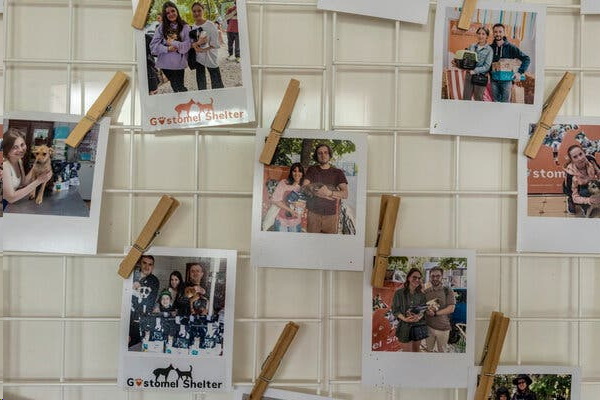
Snapshots showing some of the people who have adopted pets from the Gostomel Shelter in Ukraine. Over the past two years, groomers and dog shelters have reported a surge in purchases and adoptions.
In Kyiv, the most popular companions seem to be small, fluffy dogs that people cannot resist petting. Bichons frisés and poodles have become ubiquitous on the streets of the capital, trotting confidently past army recruitment posters and military all-terrain vehicles, or lounging next to their owners during yoga classes.
After more than 30 months of war, many dog owners say their pets have become integral members of their families, sharing in the new realities of wartime life. Like their owners, they have been roused at night by air-raid alerts, scared by nearby explosions and have endured widespread blackouts.
The founder of Pesik Co, a dog clothing brand, said she hugged her Italian greyhound during attacks on her hometown, Kharkiv. “It feels easier and warmer together,” she said at her stand at the festival in Kyiv. One owner said she had long resisted buying a dog, despite her 12-year-old daughter’s persistent requests. But after the war broke out, she said she thought a puppy might help her daughter “focus on better things than this violence. She bought Cookie, a bundle of endless energy. “He’s always doing something cute and fun.”
A groomer and owner of five Yorkies and one poodle, noted that, unlike most Ukrainians, dogs did not spend hours scrolling through social media where gruesome videos of bombings and battlefield combat now abound. Grooming them, she said, helps her focus on things removed from the grim realities of the war. “You need to feed them, bathe them, walk them and give them attention,” she said. “You could say it has a therapeutic effect.”
Research conducted on Ukranian pet owners during the war confirms the healing presence of dogs, said a Ukrainian psychologist and a professor at the Kyiv-based Taras Shevchenko National University. She said that injured soldiers returning from the front often rehabilitated and re-adapted faster to civilian life if they stayed at homes with dogs.
Ukraine’s dog-loving culture is no nascent phenomenon. Roughly five million dogs lived in the country before Russia invaded or about one for every three households. By comparison, about half of American households own a dog.
But the war has expanded this culture. A study by Suziria, one of Ukraine’s leading pet industry companies, reported a 27% growth in the pet products and services market last year and predicted double-digit growth for 2024.
At the PesDay festival, some of the most popular stands featured dog clothing — T-shirts with stripes or leopard motifs, cotton jackets adorned with embroidered sleeves, and trekking-style hats with drawstrings to tie them around the dogs’ necks. Attendees eagerly dressed their pets in the outfits, placing them on wooden tables as if hosting a fashion show.

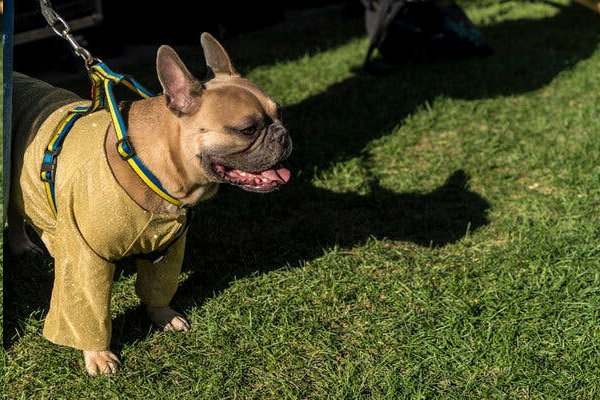
A French bulldog at the PesDay festival. Some of the most popular stands featured dog clothing.
The dog-owning craze has also been fueled by a wave of empathy for dogs abandoned by their owners during the fighting and evacuated at great risk by volunteers from the front line. There are about 140,000 stray animals in Ukraine today, twice as many as before the war, and their numbers in shelters have skyrocketed.
The Gostomel Shelter today houses some 500 dogs. Many people began adopting dogs after Russian forces were pushed back from the Kyiv suburbs in 2022. An explosion at a dam in southern Ukraine in 2023 that caused major flooding, killing many animals along with dozens of people, also spurred animal adoptions.
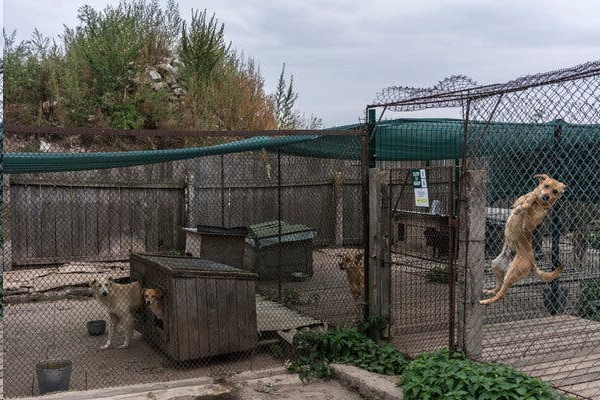
Some of the dogs kept at the Gostomel Shelter. The dog-owning craze has also been fueled by a wave of empathy for dogs abandoned by their owners.
People were eager to help. A third of the dogs there had been abandoned during the war, and many were now experiencing traumas: They do not want to be held and dash away upon hearing sounds that resemble bombings.
Several new dog owners spoke of a “now or never” moment, saying the war pushed them to act on a long-delayed decision to buy or adopt a dog, fearing that their lives could be disrupted at any moment. They likened the desire for a dog to that of having a child but without the heavier responsibilities of raising a newborn in wartime. (Ukraine’s birthrate, already low, has dropped to the lowest in the world today, according to the C.I.A.’s World Factbook.
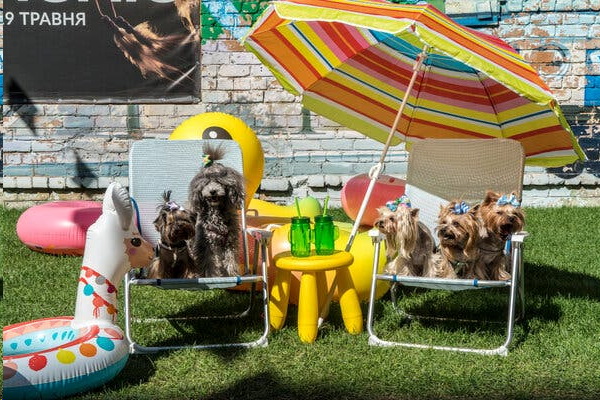
Some of the dogs at the dog festival. Grooming them helps the owner focus on things removed from the grim realities of the war.
